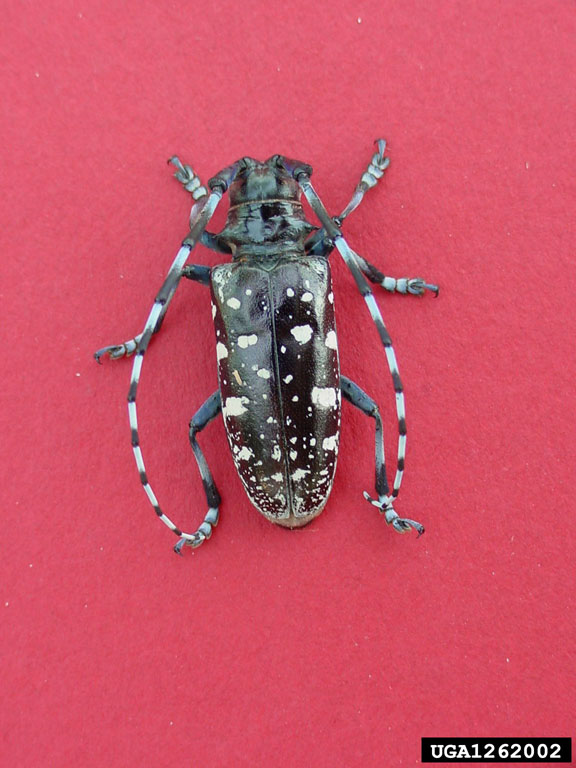Asian Longhorned Beetle
 The Asian longhorned beetle (Anoplophora glabripennis) is an exotic insect that threatens a wide variety of hardwood trees in Kansas. It is suspected that Asian Longhorned Beetle (ALB) came to the U.S. via wood packing material from Asia. Tens of thousands of trees have been destroyed since it was first discovered in Brooklyn, New York in 1996. This beetle feeds on a wide variety of hardwood tree species that are native or planted in Kansas. It kills trees by creating large tunnels as larvae causing branches or stems to break and eventually lead to tree death. Because this beetle is not native to North America, it has no known natural enemies, and our trees have low resistance to this pest. It has not been detected in Kansas. It has been stated that if the ALB were to become established in the US, it could become one of the most destructive and costly pests ever to industry, urban neighborhoods, and natural forests.
The Asian longhorned beetle (Anoplophora glabripennis) is an exotic insect that threatens a wide variety of hardwood trees in Kansas. It is suspected that Asian Longhorned Beetle (ALB) came to the U.S. via wood packing material from Asia. Tens of thousands of trees have been destroyed since it was first discovered in Brooklyn, New York in 1996. This beetle feeds on a wide variety of hardwood tree species that are native or planted in Kansas. It kills trees by creating large tunnels as larvae causing branches or stems to break and eventually lead to tree death. Because this beetle is not native to North America, it has no known natural enemies, and our trees have low resistance to this pest. It has not been detected in Kansas. It has been stated that if the ALB were to become established in the US, it could become one of the most destructive and costly pests ever to industry, urban neighborhoods, and natural forests.
What does ALB look like?
The Asian Longhorned Beetle is approximately 1-1.5 inches long. It has long antennae that are longer than the insects body and have black and white bands. The beetle body is shiny and black with irregular white spots. It has 6 legs and may have blue feet.
What are the signs ALB has attacked a tree?
Usually the upper crown is the first place to notice any damage. Adult females will chew through the bark and lay a single egg around 35-90 sites on the tree. These oval or round oviposition scars are visible on the surface of the tree (up to ½ an inch in diameter). The eggs will hatch in 1-2 weeks and the larvae begin feeding and boring into the wood. The oviposition sites look like darkened wounds in the bark or ooz sap (especially maples) during the summer months as the larvae feed. As the larvae get older, coarse sawdust and frass are noticeable around the entrance holes, around the base of trees or where branches meet the main stem. The larvae overwinter in the tree, and emerge as adults in late spring with a lifecycle of one year. These exit holes are massive, roughly 3/8 of an inch in diameter round holes, that can be found anywhere on the tree including branches, trunk, and exposed roots. Adult beetles are usually active from May to October, with peak activity in midsummer.
Control/Treatment Options
Presence of oviposition sites or exit holes indicates an infestated tree. APHIS recommends removal or chemical treatment of all ALB host material up to ½ mile radius of infested hosts.
Hosts for control purposes include: Acer spp., Aesculus spp., Albizia julibrissan, Betula spp, Celtis spp, Cercidiphyllum spp., Fraxinus, spp., Platanus spp., Populus spp., Salix spp., Sorbus spp., and Ulmus spp.